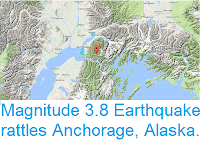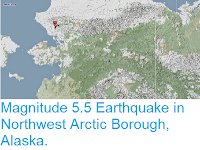The Alasaka Volcano Observatory reported an eruption on Bogoslof Island in the Aluetian Chain at about 4.10 pm local time on Wednesday 21 December 2016, the first such eruption since 1992. The eruption produced an ash column which rose about 35 000 m above the uninhabited island and was witnessed from a number of aircraft. This was followed by a second eruption at about 1.20 am on Thursday 22 December, which was not directly observed but detected by the seismic network than monitors Earthquakes in the region; a steam plume about 150 m high was later seen over the island.
Eruption on Bogoslof Island observed from an aircraft. Yahoo News.
Bogoslof Island forms the tip of a submarine volcano that rises from the Bering Sea floor, 1.8 km below the surface. The island only rises 150 m above the surface, but is 1.76 km in length and 500 m wide, forming part of the rim of the caldera (crater) of the volcano; all eruptive activity occurs beneath the surface to the northeast of the island itself.
The nature of the island means that it is frequently reshaped by eruptions, and this week's events have been no exception, with much of the northeastern side of the volcano having been removed by a collapse into the caldera, while new material has been added on the south and southwest sides of the volcano, and a new island has formed to the northeast of the submerged caldera.
An analysis of material added to and lost from Bogoslof Island during the December 2016 eruptions. Areas marked with a '-' have been lost during the event, while areas marked with a '+' have gained material, rising in altitude where land is indicated and rising from the sea in areas marked as sea in the base image. Alaska Volcano Observatory/USGS.
Bogoslof Island is uninhabited, and the islands around is are home to at most sparse Human populations, however it still presents a serious threat to air-traffic, as the Aleutian Islands lie in the path of a number of commercial aircraft routes, connecting the US to East Asia. Volcanic ash is extremely hazardous to aircraft in a number of ways. At
its most obvious it is opaque, both visually and to radar. Then it is
abrasive, ash particles physically scour aircraft, damaging components
and frosting windows. However the ash is most dangerous when it is
sucked into jet engines, here the high temperatures can melt the tiny
silica particles, forming volcanic glass which then clogs engine. When
this happens the only hope the aircraft has is to dive sharply, in the
hope that cold air passing through the engine during the descent will
cause the glass to shatter, allowing the engine to be restarted.
Obviously this is a procedure that pilots try to avoid having to
perform.
The approximate location of Bogoslof Island. Google Maps.
The volcanoes of the Alaskan Peninsula and Aleutian Islands are fed by
magma rising from the Pacific Plate, which is being subducted beneath
the North American Plate to the south along the Aleutian Trench. As the
subducting plate sinks into the Earth it is subjected to enormous heat
and pressure, causing more volatile minerals to melt. These then rise
through the overlying North American plate as magma, fuelling the Alaskan
volcanoes.
How the subduction of the Pacific Plate beneath the North American
Plate fuels the volcanoes of Alaska. Alaska Volcano Observatory.
See also...
Follow Sciency Thoughts on Facebook.










